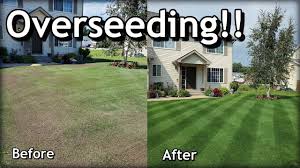As winter fades and the signs of spring emerge, homeowners often look to rejuvenate their lawns. One of the most effective ways to bring tired grass back to life and achieve a lush, green lawn is by overseeding lawns in spring. This process involves planting new grass seed over an existing lawn to fill in bare spots, improve grass density, and enhance the overall appearance and health of the turf.
Why Overseed in Spring?
Spring is a popular time for overseeding because it offers the perfect blend of mild temperatures, increased rainfall, and extended daylight—all conditions that support seed germination and early grass growth. If your lawn suffered from winter damage, disease, or heavy foot traffic, overseeding lawns in spring gives it a much-needed boost. The new grass helps crowd out weeds, reducing the need for chemical herbicides and creating a more sustainable lawn over time.
Benefits of Overseeding
Overseeding offers a wide range of benefits for homeowners:
- Thicker Turf: Adding new grass seed thickens the lawn, creating a plush, carpet-like appearance.
- Improved Resilience: A denser lawn is more resistant to pests, diseases, and drought.
- Enhanced Appearance: Overseeding can help even out the color and texture of your lawn, especially if you’re introducing newer, hardier grass varieties.
- Reduced Weeds: By filling in bare patches, overseeding minimizes room for weeds to take hold.
- Stronger Root System: New grass varieties often develop deep root systems that support long-term lawn health.
Choosing the Right Grass Seed
Selecting the appropriate grass seed is crucial for successful overseeding lawns in spring. Consider your climate, lawn usage, and sun exposure. Cool-season grasses like Kentucky bluegrass, perennial ryegrass, and fine fescues are typically best for spring overseeding in northern regions. These varieties germinate quickly and establish well in cooler temperatures. Southern homeowners may consider warm-season grasses but may find better results overseeding in late spring or early summer when the soil has warmed sufficiently.
Look for high-quality seed blends that include disease-resistant and drought-tolerant varieties. Investing in good seed will pay off in the long run with a healthier and more attractive lawn.
Preparing the Lawn for Overseeding
To ensure the best results, proper lawn preparation is essential:
- Mow Low: Cut the grass shorter than usual (about 1.5 to 2 inches) to allow new seed to reach the soil.
- Rake or Dethatch: Remove dead grass, leaves, and thatch buildup to expose the soil and improve seed-to-soil contact.
- Aerate: If your soil is compacted, core aeration helps loosen it and creates pathways for water, air, and seed penetration.
- Soil Testing: Consider testing your soil’s pH and nutrient levels. Add lime or fertilizer as needed to correct imbalances.
The Seeding Process
Once the lawn is prepared, it’s time to spread the seed:
- Apply Evenly: Use a broadcast or drop spreader to distribute the seed evenly across the lawn.
- Topdress (Optional): Lightly cover the seeds with a thin layer of compost or topsoil to help retain moisture and protect from birds.
- Water Consistently: Keep the soil consistently moist during germination, typically watering lightly once or twice daily for the first two weeks.
- Avoid Heavy Traffic: Limit foot traffic until the new grass becomes established.
Post-Seeding Care
After germination, continue caring for your lawn by:
- Resuming regular mowing once the grass reaches about 3 inches in height.
- Applying a balanced fertilizer to support new growth.
- Avoiding weed control products for at least 4-6 weeks after overseeding, as these can harm tender new grass.
Professional Overseeding Services
While many homeowners choose to overseed themselves, professional services can ensure optimal results. Experts can assess your lawn’s condition, recommend the best seed types, and use specialized equipment for even distribution and soil preparation. One such provider is emeraldlawnandturf.com, known for their customized lawn care services that promote healthy, vibrant lawns year-round.
Final Thoughts
Overseeding lawns in spring is a smart, proactive way to revitalize your lawn after winter and ensure it stays green and healthy throughout the year. With the right timing, preparation, and care, you can enjoy a lush, resilient lawn that enhances your home’s curb appeal and outdoor enjoyment. Whether you do it yourself or call in the pros, spring is the ideal time to give your lawn the fresh start it deserves.
4o
